1
ShipbuildingTatamagouche, Wallace, River John, Brule, and the surrounding shore have a long history of building and sailing ships for local and international use. Shipbuilding and the associated lumber industry employed many men and helped to develop a strong economy - for a while.
The majority of early ships ran from 7 to 67 tons, with crews of two to four men. Used in coastal trading, with loads of grindstones, lumber, and farm products, vessels returned with cargoes of manufactured goods and coal.
In 1867, the National Geographical Society reported that there were more ships registered in Nova Scotia than anywhere else in the world. Until the 1880s, Nova Scotia also had the largest ship tonnage per thousand population than all other countries.
Shipbuilding was a large part of the culture on the North Shore of Nova Scotia. During Tatamagouche's 125 years of shipbuilding dominance, over 311 vessels were launched from the area's yards. Today, no-one remembers the fully rigged schooners built on the shore, but many can contribute stories and folklore from the fascinating 'Golden Age of the Ships'.
Even when shipbuilding had vanished from other areas, River John hung on, perhaps through tradition, and the fact there was still a niche for the wooden sailing ship, at least locally.
2
4) SHIPBUILDING - Former Sites in River John, Nova Scotia, CanadaLate 20th Century
River John, Nova Scotia, Canada
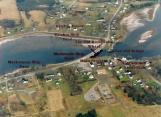 Credits:
Credits:River John Library
Rhianna H. Watt (Thesis-1987)
3
River JohnThis is showing the principle shipyards: Alexander MacKenzie (building from 1833 - 1965), Charles McLennan (nephew to MacKenzie and working there from 1844 - 1918) and James Kitchin Sr and Jr (building from 1845 - 1884). Reading various accounts, the details of dates and spelling of names seem to vary, which can be confusing.
One record states that between 1820 and 1884 over twenty different men are listed as ship builders at River John. According to R.H. Watt writing in1987, there were 10 major builders operating at various times.
Robert McKay 1820 - 1830 (Possibly building earlier than this)
George Smith 1837 - 1847 (On Smith Point at the extreme edge of the village)
Kenneth MacLean 1838 - 1841
Alexander MacKenzie 1833 - 1865
John Mockler 1836 - 1865 (He moved his yard to Brule)
James Kitchen Sr 1845 - 1869
Charles McLennan 1865 -1885 (worked for Alexander MacKenzie prior to this time but owned his own yard in 1865)
James Kitchen Jr 1869, 1884/5
Archibald MacKenzie 1875 - 1890 (building lapsed until 1918 when he built another vessel)
MacKenzie and Lauder 1876 - 1888
MacKenzie and Gordon 1882 - 1887
C.H.McLennan 1890 - 1902 (built no ships between 1902 and 1918)
4
Site of the East Bank Shipyards Today, River John, Nova Scotia, Canada13 July 2010
River John, Nova Scotia, Canada
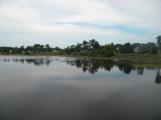 Credits:
Credits:S. Brinkhurst
5
At one time there were four yards on the west side of the harbour and three on the east. The first ship in River John, "Mary", was built in 1825 by Robert MacKay. His lumber business failed and was taken over by Alexander MacKenzie.The ship-building industry was well established by 1835. By 1870 there were only two working yards, but River John continued to build ships when other places had ceased.
6
West Bank, River John, Nova Scotia, Canada1879
River John, Nova Scotia, Canada
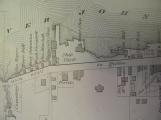 Credits:
Credits:Peter MacDonald
7
One of the most successful of the shipyards was that run by James Kitchin Sr. and Jr. who built one to three ships a year over a thirty year period. Kitchen and his son employed the designer/ foreman Duncan Johnson.After 1860 the yard followed the local trend to build larger ships; some were sold but others remained in the hands of the builder who made use of the opportunity to sell goods globally, and take advantage of the increased freight rates.
On his father's death, James Kitchen Jr. took over the shipyard, running it for 11 years and producing 4 full-rigged ships of 1000 tons to 1687 tons, as well as barques and schooners. The last built (1884), the "Warrior" was the largest built in Pictou County. "Warrior" was a 1611 ton, full-rigged, three masted vessel with masts made of wood and steel, each carrying 7 sails. She was eqipped with an enclosed wheel house, unusual for the time; she was capable of 12 knots in favourable conditions. Captain Kitchin often commanded her until she was sold to an Italian Company in 1900, but she was considered an unlucky ship, having numerous accidents.
8
James Kitchin House and Shipyard, River John, Nova Scotia, Canada1879
River John, Nova Scotia, Canada
 Credits:
Credits:River John Library
9
In the late 1800s, James Kitchen Jr. was one of the major shipbuilders in River John. He was in constant but friendly competition with the McLennan shipyards. His property on the east side of the river was an extensive one, with a fine house and grounds, and he was a wealthy man. A master mariner, merchant, and leading citizen of River John, James Kitchen Jr. was interested in horse racing and ran a horse breeding farm, helping to improve the local livestock. Eventually a number of his financial interests failed; these set backs led to the closing of the shipyard and a considerable loss of income. By 1900 he had no shares left in shipping investments.Many stories circulated over the years of shipping, voyages, and shipwrecks. A popular one is the mystery of the "Isabella", a schooner of 50 tons. It was built by John Millar of New Annan and sailed for Buenos Aires in South America. The ship was never heard from again. It was most likely lost on the Cape Breton side of the Strait of Canso, as it was carrying stones from a Waugh's River quarry and similar stones were found on that shore. Regardless, the story still haunts the natives of Tatamagouche, to the extent that many claim to have seen a burning ship on the Northumberland Strait, rumoured to be "Isabella".
10
McLennan Shipyard (II), River John, Nova Scotia, CanadaEarly 1900's
River John, Nova Scotia, Canada
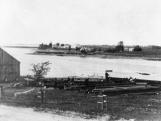 Credits:
Credits:North Shore Archives CSHC
11
At the beginning of the shipbuilding industry in River John there were too few workmen, and men came from Lunenburg for seasonal work. There was no accommodation so the workers built shacks from scrap timber, giving rise to 'Slabtown', lying west of the shipyards.Shipyard owners also owned the shops in the village and paid with credit notices which could only be used in their shop, thus bringing money back into their business.
With the shipyards came carpenter shops, blacksmiths, and tanneries, all servicing the yards. A hotel, an inn, and a stage coach attended to visitors' needs, as did the telegraph service.The River John shipyards received telegraph services after 1861; this was important in the operation of ships abroad where contact with captains at sea was essential. It also made for quicker links to agents in foreign ports.
The shipbuilding boom of the 1840's declined until the 1850s when it revived with the demand for ships during the Crimean War, only to fall again during the 1870's, as timber ran out. The drop in fish, timber, and coal sales meant fewer ships were needed, and a surplus of ships meant freight rates dropped. Once Canada became a country in its own right,in 1867, the Prime Minister encouraged interprovincial trade, which tended to use faster steam vessels, and later, the railway.
12
McLennan Shipyard, River John, Nova Scotia, Canada1919
River John, Nova Scotia, Canada
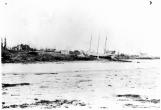 Credits:
Credits:North Shore Archives CSHC
13
Alexander MacKenzie was brother-in-law to Alexander Campbell of Tatamagouche. He built a variety of barques,ships, brigantines, brigs, and schooners for 50 years on the west side of the river. His younger son, Archibald, later continued the business.Charles McLennan was a nephew to Alexander MacKenzie, and he joined him in the business during the 1840's. He founded a small shipyard in 1840 on the east bank, where he was responsible for some ships registered in his name, and had shares in others that he built. He bought the MacKenzie yard when Alexander died in 1865. By then the British market was drying up but there were lucrative opportunities with the American markets. His position as a manager/owner for some ships was made much easier with the coming of the telegraphic service, which he and the James Kitchen shipyard both used. Rapid connections with agents across the world was a great advantage. He continued to be a shareholder in many ships.
When Charles McLennan retired in 1875, the business was taken over by Alexander MacKenzie's son, Archibald. By this time McLennan owned a general store in River John as well as the hotel and was responsible for the railway actually coming to the village and not by-passing it.
Archibald was in partnership with a Captain William Lauder from 1876 to 1878, building barques. He then partnered with George Gorden until 1887 during which time they built the full-rigged ship, the "Caldera" of 1574 tons. After this there was a lull in building until 1890 when Archibald experimented with the larger barquentines, with their greater speed but less capacity, but it was not a success.
After this ill fated experiment, he retired and the yard went to Charles McLennan's son, C.H.McLennan.
1904 saw Archibald MacKenzie working in the lumber trade and the lobster industry. He did return to ships in World War I, when he built the 'Cambrai' in response to the need for shipping in the war.
He died in 1925, and none of his six sons were interested in shipbuilding as a career.
14
"Mary F. Anderson" at River John, Nova Scotia, Canada1920
River John, Nova Scotia, Canada
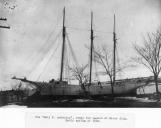 Credits:
Credits:North Shore Archives CSHC